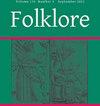‘He Could Raise and Lay Ghosts at His Will’: Victorian Folklorists and the Creation of Early Modern Clerical Ghost-Laying
IF 0.2
4区 社会学
0 FOLKLORE
引用次数: 0
Abstract
Abstract Folk legends of brave clergymen confronting terrifying apparitions in fields and houses can be heard all throughout rural England. Situated in the early modern period, these tales establish the archetype of the ‘conjuring parson’ and perpetuate the spiritual tradition of ‘ghost-laying’: the exorcism of ghosts. Clerical ghost-laying, however, is a spiritual tradition without a well-founded historical or theological precedent. The few extant sixteenth- and seventeenth-century literary depictions of this practice are largely satirical or polemical in nature. Tales of early modern clergymen exorcising restless spirits actually originate from the pens of Victorian authors who developed the sensationalist folkloric exploits of conjuring parsons to fulfil their own literary or political agendas. Through a comparison of early modern and Victorian literary accounts—focusing on the Botathen Ghost haunting—this article illustrates that the genre of clerical ghost-laying lacks any substantial claim to historical, literary, or theological legitimacy.“他可以随心所欲地养鬼和放鬼”:维多利亚民俗学家和早期现代牧师放鬼的创作
勇敢的牧师在田野和房屋中面对可怕的幽灵的民间传说,在整个英格兰农村都可以听到。这些故事发生在近代早期,确立了“会召唤的牧师”的原型,并延续了“放鬼”的精神传统:驱鬼。然而,神职人员放鬼是一种精神传统,没有充分的历史或神学先例。现存为数不多的16和17世纪文学对这种做法的描述,本质上主要是讽刺或论战。早期现代牧师驱走不安分的灵魂的故事实际上起源于维多利亚时代作家的笔,他们发展了煽情的民间传说,利用召唤牧师来实现自己的文学或政治议程。通过对早期现代和维多利亚时期的文学描述的比较——重点是波塔森鬼的纠缠——这篇文章说明了神职人员放鬼的类型在历史、文学或神学上缺乏任何实质性的合法性。
本文章由计算机程序翻译,如有差异,请以英文原文为准。
求助全文
约1分钟内获得全文
求助全文
来源期刊

FOLKLORE
FOLKLORE-
CiteScore
0.60
自引率
25.00%
发文量
0
期刊介绍:
A fully peer-reviewed international journal of folklore and folkloristics. Folklore is one of the earliest journals in the field of folkloristics, first published as The Folk-Lore Record in 1878. Folklore publishes ethnographical and analytical essays on vernacular culture worldwide, specializing in traditional narrative, language, music, song, dance, drama, foodways, medicine, arts and crafts, popular religion, and belief. It reviews current studies in a wide range of adjacent disciplines including anthropology, cultural studies, ethnology, history, literature, and religion. Folklore prides itself on its special mix of reviews, analysis, ethnography, and debate; its combination of European and North American approaches to the study of folklore; and its coverage not only of the materials and processes of folklore, but also of the history, methods, and theory of folkloristics. Folklore aims to be lively, informative and accessible, while maintaining high standards of scholarship.
 求助内容:
求助内容: 应助结果提醒方式:
应助结果提醒方式:


